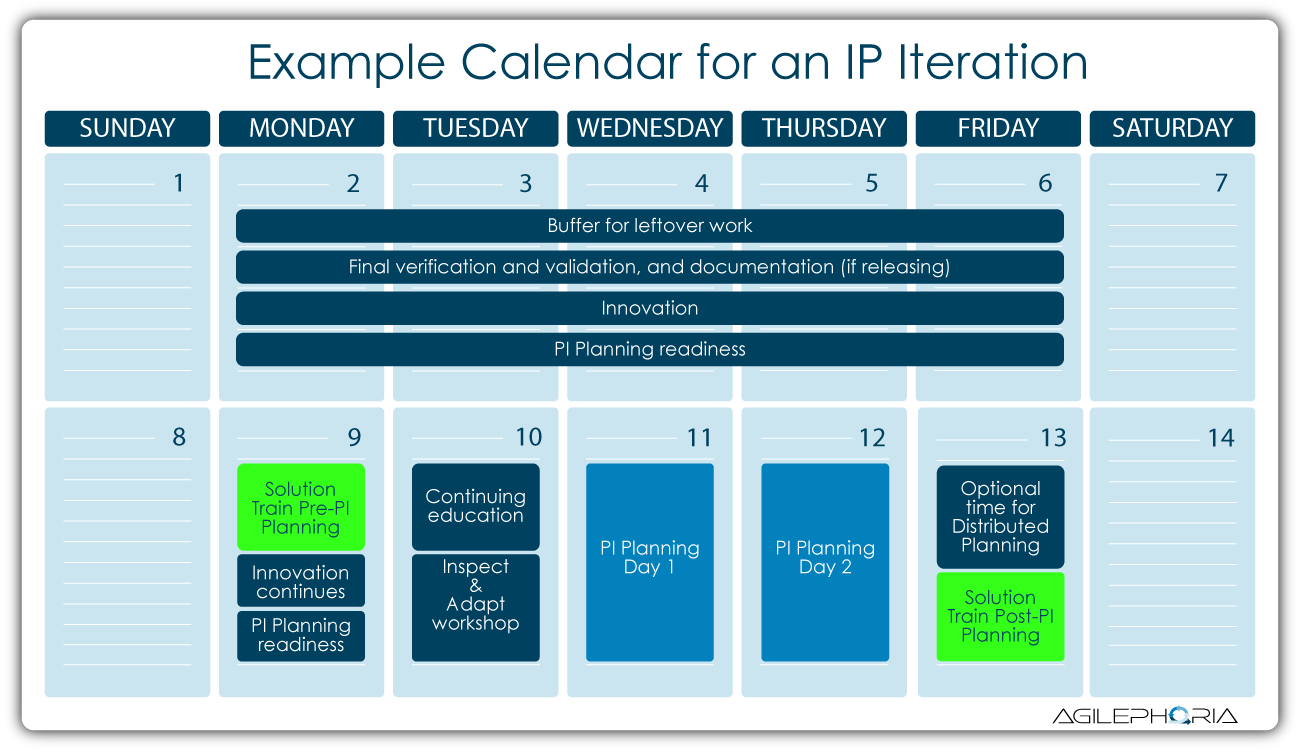Innovation and Planning (IP) Iteration represents a unique opportunity for teams to work on innovation and improvements. It gives them time to reset their brains, recharge their batteries and sharpen their tools, creatively think of some other problems, learn, and grow. This will improve their overall efficiency, velocity, and job satisfaction, and help the team not to burn out and be the heroes an organization needs to thrive.
In SAFe® (Scaled Agile Framework or Enterprises®), there is an intense focus on continuous customer value delivery, and people are busy working on Features they committed to during PI Planning. Because of this intense and unrelenting attention to solution delivery, there isn’t much time for innovation. But, the fact is, that without innovation, you die – as the organization on the market, against your competitors. To solve this issue, SAFe provides dedicated Innovation and Planning (IP) Iterations.
 What is an IP Iteration?
What is an IP Iteration?
Iteration and Planning (IP) iteration is a regular cadence-based opportunity that occurs at the end of every Program Increment (PI). It has a standard schedule and format, and it serves multiple purposes:
– It provides dedicated time for innovation, exploration, backlog refinement and PI events, such as PI Planning, and Inspect and Adapt (I&A);
– It provides an estimating buffer for meeting PI objectives and enhancing the predictability of PI performance;
– It prevents that the ‘tyranny of the urgent’ – intense focus on continuous customer value delivery – will override any opportunity to innovate;
– It provides time to work on technical infrastructure, tooling and other impediments to delivery;
– It makes a great opportunity for cross training to develop skills in new domains, development languages and systems.

Innovation and Planning (IP) Activities
Time for innovation and exploration
Although innovation represents one of the four pillars of Lean-Agile Mindset and the SAFe House of Lean, finding time to innovate can be very challenging. This is where IP iterations help. Many enterprises use them for research and design activities such as hackathons. They are fun and fruitful for an organization, as well as beneficial for individual employees. In SAFe Hackathons are not only reserved for developers, as every idea is valuable and each person participating is appreciated. In fact, all the people on the program are welcome – developers, testers, agile coaches, Product Owners, Product Managers, architects … During hackathons people can work on whatever they want, with whomever they want, so long as the work reflects the mission of the company. At the end of the event, they demo their work to others and the learnings routinely make their way into Program Backlogs. In this way hackathons represent a fun activity that helps drive innovation.
Time to work on technical infrastructure, tooling, and other impediments to delivery
Agile teams highly depend on their working environments, so time must be spent improving them. IP iteration represents a perfect time to improve infrastructure or perform a migration, as teams aren’t in the middle of critical work. It is also a great opportunity to work on improvement stories from team’s Iteration Retrospective or Enablers, such as implementing new automation frameworks, adopting Agile project management tooling, upgrading, or enhancing cross-team and train communications systems.
Dedicated time to PI events
Because PI events such as Inspect & Adapt, PI Planning and final prioritization of Features using Weighted Shortest Job First (WSJF) are performed during the IP iteration, they don’t decrease the velocity of regular influence. Thanks to the cadence-based IP Iteration, these events are also better guaranteed, held on a regular cadence, and scheduled well in advance.
Time for education
Although technologies, methods and practices change all the time, there usually aren’t many opportunities for continuing education. IP iterations are a perfect time for this investment. They enable a culture of continuous learning and give teams and leaders an opportunity to learn and master new skills and techniques, such as:
– feature and story writing
– building in quality automated testing
– collective ownership
– agile architecture
– continuous integration
– pair work
– mastering product owner and scrum master roles
– team building
IP iterations not only enable employee mastery, but also increase job satisfaction, velocity and reduce time-to-market and represent a great opportunity to launch and support Communities of Practice. Additionally, investing in people will create a ‘T-shaped’ (deep skill in one area, working knowledge in multiple other areas) and even ‘E-shaped’ (deep skill in more than one area) workforce and provide maximum agility and flexibility to deliver the most important backlog items.
Time for the final integration of the solution
The PI System Demo occurs at the end of each PI. For ARTs that are part of a bigger Solution Train, the PI System Demo feeds into the aggregate Solution Demo, which takes place during the IP Iteration. Solution Demo is more structured and formal affair, and it demonstrates the accumulation of all the features and capabilities developed over the course of the entire Program Increment for a Solution Train. Because of its complexity – especially when a solution includes hardware and other components that are harder to integrate end-to-end continuously, full integration can only be feasible during the IP Iteration. However, it should not be the only attempt to integrate the assets into the system – it should happen regularly over the course of the PI, with a total solution integration occurring at least once per PI (@Scaled Agile, Inc.).
Time for final readiness activities
IP Iteration provides time for final user acceptance testing and documentation and other readiness activities that are not feasible or economical to perform every iteration.
Leverage the built-in estimation buffer
Planning to full capacity leads to delays in value delivery and unpredictability. As the ART doesn’t plan features or stories for the IP Iteration during PI Planning, IP Iteration offers buffer to prevent carrying unfinished work from current PI to the next one. This substantially increases the predictability of the program’s outcomes and increases team’s ability to meet Team and Program PI Objectives by giving them buffer for responding to unforeseen events, delays resulting from dependencies and other issues. At this point it should be emphasized that the buffer should not be abused. Routinely using that time for completing work will lead to failure and innovation will likely suffer.
Reasons not to skip the IP Iteration
IP Iterations represent a very important element of SAFe. Without them, there would be no time for education, cross-training and exploring new technologies, frameworks, automations, and processes. There would also be no time to work on reducing technical debt and no slack time that helps increase the morale and motivation and is fundamental for people to reset their brains and start thinking creatively.
Without IP Iteration there would be no buffer that prevents carrying unfinished work into following PI, RTEs wouldn’t have time to prepare for PI Planning and there would be no opportunity for the whole ART to run a retrospective and problem solving workshops and solve issues that cannot be fixed on team level.
All the above are reasons that make IP Iteration necessary if you want to work successfully with SAFe and leverage all its benefits. It is an opportunity for people to brainstorm new ideas, focus on new solutions, prepare for following Program Increment and reflect on previous one.







